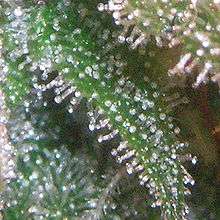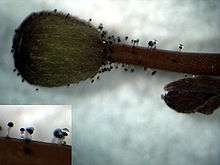Trichome


Trichomes (/ˈtraɪkoʊmz/ or /ˈtrɪkoʊmz/), from the Greek τρίχωμα (trichōma) meaning "hair", are fine outgrowths or appendages on plants, algae, lichens, and certain protists. They are of diverse structure and function. Examples are hairs, glandular hairs, scales, and papillae. A covering of any kind of hair on a plant is an indumentum, and the surface bearing them is said to be pubescent.
Algal trichomes
Certain, usually filamentous, algae have the terminal cell produced into an elongate hair-like structure called a trichome. The same term is applied to such structures in some cyanobacteria, such as Spirulina and Oscillatoria. Cyanobacteria trichomes may be unsheathed, as in Oscillatoria, or sheathed, as in Calothrix.[1] These structures play an important role in preventing soil erosion, particularly in cold desert climates. The filamentous sheaths form a persistent sticky network that helps maintain soil structure.
Plant trichomes



Aerial surface hairs
Trichomes on plants are epidermal outgrowths of various kinds. The terms emergences or prickles refer to outgrowths that involve more than the epidermis. This distinction is not always easily applied (see Wait-a-minute tree). Also, there are nontrichomatous epidermal cells that protrude from the surface.
A common type of trichome is a hair. Plant hairs may be unicellular or multicellular, branched or unbranched. Multicellular hairs may have one or several layers of cells. Branched hairs can be dendritic (tree-like) as in kangaroo paw (Anigozanthos), tufted, or stellate (star-shaped), as in Arabidopsis thaliana.
Another common type of trichome is the scale or peltate hair, that has a plate or shield-shaped cluster of cells attached directly to the surface or borne on a stalk of some kind. Common examples are the leaf scales of bromeliads such as the pineapple, Rhododendron and sea buckthorn (Hippophae rhamnoides).
Any of the various types of hairs may be glandular, producing some kind of secretion, such as the essential oils produced by mints and many other members of the family Lamiaceae.
In describing the surface appearance of plant organs, such as stems and leaves, many terms are used in reference to the presence, form, and appearance of trichomes. The most basic terms used are glabrous—lacking hairs— and pubescent—having hairs. Details are provided by:
- glabrous, glabrate – lacking hairs or trichomes; surface smooth
- hirsute – coarsely hairy
- hispid – having bristly hairs
- articulate – simple pluricellular-uniseriate hairs
- downy – having an almost wool-like covering of long hairs
- pilose – pubescent with long, straight, soft, spreading or erect hairs
- puberulent – minutely pubescent; having fine, short, usually curly, hairs
- pubescent – bearing hairs or trichomes of any type
- strigillose – minutely strigose
- strigose – having straight hairs all pointing in more or less the same direction as along a margin or midrib
- tomentellous – minutely tomentose
- tomentose – covered with dense, matted, woolly hairs
- villosulous – minutely villous
- villous – having long, soft hairs, often curved, but not matted
Hairs on plants are extremely variable in their presence across species and even within a species, such as their location on plant organs, size, density, and therefore functionality. However, several basic functions or advantages of having surface hairs can be listed. It is likely that in many cases, hairs interfere with the feeding of at least some small herbivores, and, depending upon stiffness and irritability to the palate, large herbivores as well. Hairs on plants growing in areas subject to frost keep the frost away from the living surface cells. In windy locations, hairs break up the flow of air across the plant surface, reducing transpiration. Dense coatings of hairs reflect sunlight, protecting the more delicate tissues underneath in hot, dry, open habitats. In addition, in locations where much of the available moisture comes from fog drip, hairs appear to enhance this process.
Root hairs
Root hairs, the rhizoids of many vascular plants, are tubular outgrowths of trichoblasts, the hair-forming cells on the epidermis of a plant root. That is, root hairs are lateral extensions of a single cell and only rarely branched. Just prior to the root hair development, there is a point of elevated phosphorylase activity. Root hairs vary between 5 and 17 micrometres in diameter, and 80 to 1,500 micrometres in length (Dittmar, cited in Esau, 1965). Root hairs can survive for two to three weeks and then die off. At the same time new root hairs are continually being formed at the top of the root. This way, the root hair coverage stays the same. It is therefore understandable that repotting must be done with care, because the root hairs are being pulled off for the most part. This is why planting out may cause plants to wilt.
Significance for taxonomy
The type, presence and absence and location of trichomes are important diagnostic characters in plant identification and plant taxonomy.[2] In forensic examination, plants such as Cannabis sativa can be identified by microscopic examination of the trichomes.[3][4] Although trichomes are rarely found preserved in fossils, trichome bases are regularly found and, in some cases, their cellular structure is important for identification.
Significance for plant molecular biology
In the model plant Arabidopsis thaliana, trichome formation is initiated by the GLABROUS1 protein. Knockouts of the corresponding gene lead to glabrous plants. This phenotype has already been used in gene editing experiments and might be of interest as visual marker for plant research to improve gene editing methods such as CRISPR/Cas9.[5] Trichomes also serve as models for cell differentiation as well as pattern formation in plants.[6]

Uses
Bean leaves have been used historically to trap bedbugs in houses in Eastern Europe. The trichomes on the bean leaves capture the insects by impaling their feet (tarsi). The leaves would then be destroyed.[7]
Trichomes are an essential part of nest building for the European wool carder bee (Anthidium manicatum). This bee species incorporates trichomes into their nests by scraping them off of plants and using them as a lining for their nest cavities.[8]
Defense
Plants may use trichomes in order to deter herbivore attacks via physical and/or chemical means, e.g. in specialized, stinging hairs of Urtica (Nettle) species that deliver inflammatory chemicals such as histamine. Studies on trichomes have been focused towards crop protection, which is the result of deterring herbivores (Brookes et al. 2016).[9] However, some organisms have developed mechanisms to resist the effects of trichomes. The larvae of Heliconius charithonia, for example, are able to physically free themselves from trichomes, are able to bite off trichomes, and are able to form silk blankets in order to navigate the leaves better.[10]
Stinging trichromes
Stinging trichomes vary in their morphology and distribution between species, however similar effects on large herbivores implies they serve similar functions. In areas susceptible to herbivory, higher densities of stinging trichomes were observed. In Urtica, the stinging trichomes induce a painful sensation lasting for hours upon human contact. This sensation has been attributed as a defense mechanism against large animals and small invertebrates, and plays a role in defense supplementation via secretion of metabolites. Studies suggest that this sensation involves a rapid release of toxin (such as histamine) upon contact and penetration via the globular tips of said trichomes.[11]
See also
| Wikimedia Commons has media related to Trichome. |
References
- ↑ "Identify That Alga". Retrieved September 20, 2013.
- ↑ Davis, P.H.; Heywood, V.H. (1963). Principles of angiosperm taxonomy. Princeton, New Jersey: Van Nostrandpage. p. 154.
- ↑ Bhatia, R.Y.P.; Raghavan, S.; Rao, K.V.S.; Prasad, V.N. (1973). "Forensic examination of leaf and leaf fragments in fresh and dried conditions.". Journal of the Forensic Science Society. 13 (3): 183–190. doi:10.1016/S0015-7368(73)70794-5.
- ↑ United Nations Office on Drugs and Crime (2009). Recommended Methods for the Identification and Analysis of Cannabis and Cannabis Products (Revised and updated). New York: United Nations. pp. 30–32. ISBN 9789211482423.
- ↑ Hahn, Florian; Mantegazza, Otho; Greiner, André; Hegemann, Peter; Eisenhut, Marion; Weber, Andreas P. M. (2017). "An Efficient Visual Screen for CRISPR/Cas9 Activity in Arabidopsis thaliana". Frontiers in Plant Science. 8. ISSN 1664-462X. PMC 5258748
 . PMID 28174584. doi:10.3389/fpls.2017.00039.
. PMID 28174584. doi:10.3389/fpls.2017.00039. - ↑ Hülskamp, M.; Schnittger, A.; Folkers, U. (1999). "Pattern formation and cell differentiation: trichomes in Arabidopsis as a genetic model system". International Review of Cytology. 186: 147–178. ISSN 0074-7696. PMID 9770299.
- ↑ Szyndler, M.W.; Haynes, K.F.; Potter, M.F.; Corn, R.M.; Loudon, C. (2013). "Entrapment of bed bugs by leaf trichomes inspires microfabrication of biomimetic surfaces" (PDF). Journal of The Royal Society Interface. 10 (83). ISSN 1742-5662. doi:10.1098/rsif.2013.0174.
- ↑ Eltz, Thomas; Küttner, Jennifer; Lunau, Klaus; Tollrian, Ralph (6 January 2015). "Plant secretions prevent wasp parasitism in nests of wool-carder bees, with implications for the diversification of nesting materials in Megachilidae". Frontiers in Ecology and Evolution. 2. doi:10.3389/fevo.2014.00086.
- ↑ Karley, A (2016). "Exploiting physical defence traits for crop protection: leaf trichomes of Rubus idaeus have deterrent effects on spider mites but not aphids.". Annals of Applied Biology. 168: 159–172 – via Academic Search Premier.
- ↑ Cardoso, Márcio Z. "Ecology, Behavior and Binomics: Herbivore Handling of a Plant's Trichome: The Case of Heliconius Charithonia (L.) (Lepidoptera:Nymphalidae) and Passiflora Lobata (Kilip) Hutch. (Passifloraceae)." Neotropical Entomology 37.3 (2008): 247-52. Web.
- ↑ Fu, H. Y., Chen, S. J., & Kuo-Huang, L. L. (2003). Comparative study on the stinging trichomes and some related epidermal structures in the leaves of Dendrocnide meyeniana, Girardinia diversifolia, and Urtica thunbergiana. Taiwania, 48(4), 213-223.
- Esau, K. 1965. Plant Anatomy, 2nd Edition. John Wiley & Sons. 767 pp.